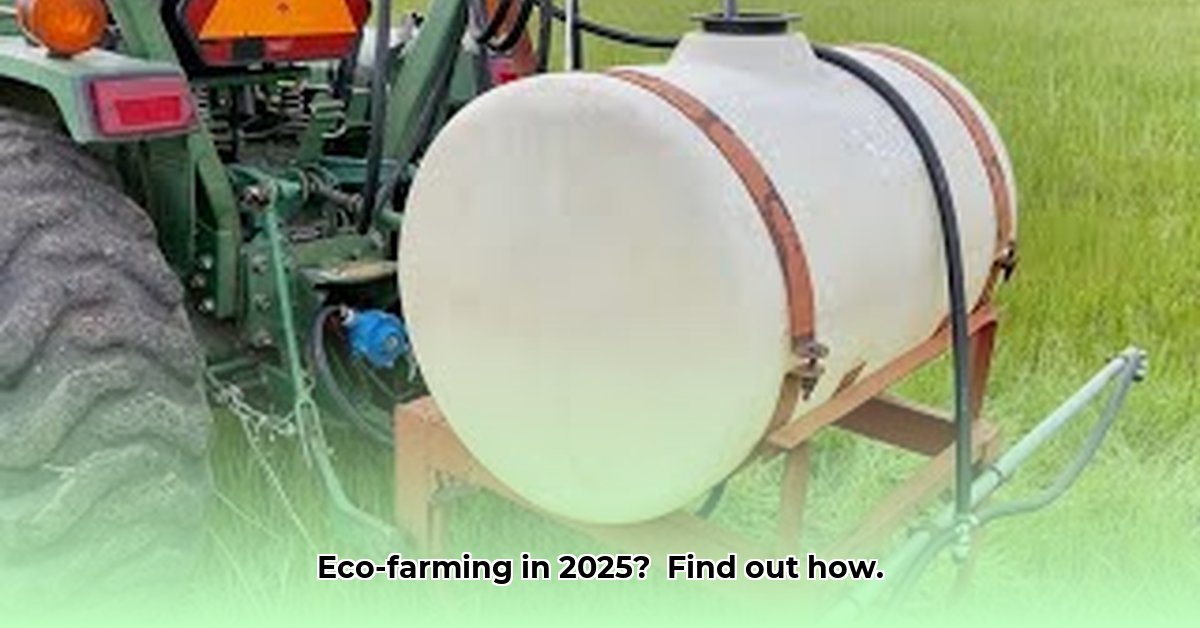
Choosing the right spray tank tractor is crucial for efficient and sustainable farming practices. This guide helps farmers, from home gardeners to large-scale commercial operations, select and utilize sprayers effectively. We'll cover essential factors to consider, from tank size and materials to advanced technologies and maintenance best practices. For more sprayer options, check out this helpful resource: Sprayer options.
Sizing Up Your Needs: Capacity and Tank Size
Determining the appropriate spray tank capacity is paramount. Overestimating leads to wasted resources; underestimating causes constant refilling, hindering productivity.
Step 1: Accurate Measurement: Measure your fields meticulously. Divide irregular areas into smaller, easily measurable sections for precise calculation.
Step 2: Spraying Requirements: Determine the gallons of spray solution needed per acre. This depends on crop type and applied chemicals. Consult local agricultural extension services or chemical suppliers for guidance.
Step 3: Capacity Selection: Estimate total tank capacity based on steps 1 and 2. A slightly larger tank is preferable to avoid frequent refilling, but avoid overspending on unnecessary capacity. Balance cost-effectiveness with operational efficiency.
Tank Material: Durability, Longevity, and Environmental Impact
The tank material impacts lifespan and environmental friendliness. Key options include:
- Steel: Durable and relatively inexpensive, but susceptible to rust, especially in humid climates.
- Polyethylene (PE): Lightweight, corrosion-resistant, and affordable, but can degrade over time. Recyclability varies.
- Stainless Steel: Exceptionally durable and corrosion-resistant, but significantly more expensive.
Recommendation: In humid environments or for long-term use, the superior durability of stainless steel justifies its higher cost. In drier climates, or for less intensive use, polyethylene or polypropylene (PP) offer a cost-effective balance. Consider the long-term costs and environmental implications of each material. Does the reduced environmental impact of a longer-lasting tank outweigh the higher initial investment?
Pump Power and Precision: Optimizing Spray Application
The pump's power influences spray consistency and coverage. Beyond power, consider these features for efficient spraying:
GPS Guidance: GPS-guided sprayers map fields, automatically adjusting application for targeted coverage, reducing overlaps, and saving chemicals and money. "GPS guidance provides substantial cost savings by minimizing chemical waste," says Dr. Emily Carter, Agricultural Engineer at Purdue University.
Variable Rate Technology (VRT): VRT varies chemical application based on soil conditions and crop density, maximizing effectiveness and minimizing usage.
Recommendation: While GPS and VRT increase initial investment, the long-term savings in chemicals and increased yields make them worthwhile, especially for large-scale operations. For smaller operations, careful evaluation of projected savings versus upfront costs is crucial.
Nozzle Know-How: Minimizing Drift and Maximizing Impact
Nozzle selection is crucial for minimizing chemical drift. Low-drift nozzles reduce environmental impact.
Recommendation: Invest in low-drift nozzles to reduce off-target chemical application. This reduces environmental contamination and ensures compliance with local regulations. The long-term environmental and cost benefits of reduced chemical use outweigh the higher initial nozzle cost.
Maintenance and Safety: Protecting Your Investment and Well-being
Regular maintenance is essential for sprayer longevity and operator safety. Regularly inspect all components for wear and tear. Clean the sprayer thoroughly after each use to prevent corrosion and chemical buildup.
Recommendation: Always follow manufacturer instructions for chemical handling and storage. Use appropriate personal protective equipment (PPE), including gloves, goggles, and a respirator. Regular maintenance prevents costly repairs and ensures operator safety.
Choosing Your Spray Tank Tractor: A Comprehensive Decision
The optimal spray tank tractor precisely fits your operation's specific needs and environmental goals. Consider these factors:
Budget: Determine your budget constraints and prioritize features accordingly.
Operation Size: The size of your operation dictates the necessary tank capacity and technology features.
Spraying Requirements: The type of crops and chemicals used affect tank size and spraying technology needs.
Sustainability Goals: Your commitment to sustainability influences material selection and technological choices.
Recommendation: Thoroughly research different models and compare features. Consult with other farmers and experts for advice before committing to a purchase.
Key Takeaways:
- Match Tank Size to Needs: Avoid under- or over-sizing your tank capacity.
- Prioritize Sustainable Materials: Stainless steel offers long-term durability; PE and PP provide cost-effective alternatives.
- Utilize Advanced Features: GPS and VRT optimize application, reducing waste; consider low-drift nozzles for minimal environmental impact.
- Maintain Regularly: Ensure long-term performance and operator safety through consistent maintenance.